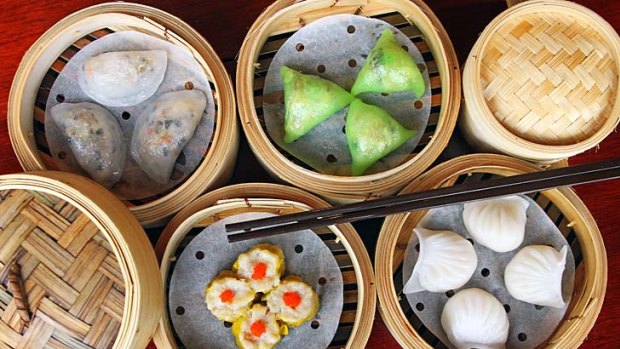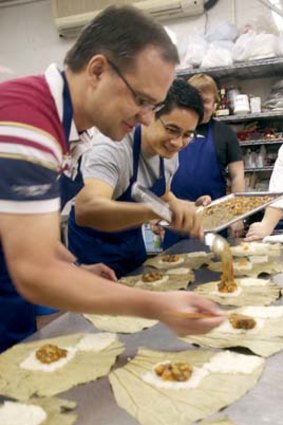
Full steam ahead... each dim sum dish involves extensive preparation.Credit: Getty Images
Penny Watson faces a stern culinary test and teacher at a Hong Kong masterclass.
I'm trying to decide if the woman barking orders at me is Hong Kong's answer to Iron Chef or just a dragon lady. In any case, I wouldn't want to be on the wrong side of her meat cleaver. It might sound like the set of a Bruce Lee movie but it's a dim sum cooking class, a six-hour intensive session on this famed southern Chinese culinary style.
Our formidable host is Martha Sherpa, a buxom Cantonese chef with an appetite for teaching cooking "the proper way". Her kitchen is a place for serious cooking no matter your skill set. Though 60 per cent of her clientele are in the cooking industry, "even professionals are beginners when it comes to Chinese cuisine", she says.

Martha Sherpa, left, looks on as students learn her recipes and techniques.Credit: Penny Watson
Our classroom is in an old high-rise in Mong Kok, a built-up urban enclave in Hong Kong's New Territories. The area has more than 2000 restaurants of varying styles and budgets and our classroom could pass for the kitchen of many of them: bamboo steamers are stacked in a corner, blackened woks line tiled walls and a pork-cuts butchery poster is framed by light coming through frosted windows. In the centre of the kitchen is a pristinely clean stainless-steel table with wooden chopping boards and cleavers. The real deal.
As Sherpa is keen to explain at the start of the day, this isn't a fancy cooking course for hotel guests. "There's no soft music or comfortable sofas. You are here to learn how to cook Chinese food. You do not come here for fun." I half expect her to slam the table with a clenched fist.
But the "no soft music" in Sherpa's approach is what attracted me. I've signed up to several cooking classes in my travels, but often they cater to those with a leisure bent. What I want is to learn proper technique and skill, along with authentic recipes. We'll get our fair share of both.
On the menu are four traditional dim sum: crispy spring rolls (chuen guen); steamed sticky rice with chicken and shiitake mushroom in lotus leaf parcels (nor mai gai); steamed sticky rice with coriander, peanuts and shrimp in yellow wrappers (nor mai bao); and steamed shrimp, pork and shiitake mushroom dumplings in yellow wrappers (sui mai).
The dishes are popular on dim sum menus the world over; however, sui mai "is the most important for Chinese people", Sherpa says, and something of an indicator for judging good dim sum. "Get the sui mai right and your friends and customers will keep coming back," she says.
It's easier said than done. The bite-size portions (also known as yum cha in Australia) make it particularly labour-intensive. Each dish involves serious preparation: vegetables sliced and diced to exact proportions and ingredients divided equally between the fillings. The fillings in turn need to be the same size.
"If one customer has a bigger dumpling or more shrimp, the others complain," Sherpa says. (It dawns on me later this may be the reason many Chinese eat dim sum at restaurants, not at home.)
If my prep work needs attention, my wok technique is laughable. Proper stir-frying is an art in itself and mastering good wok technique is essential for Chinese cooking. The trick is to shovel the ingredients on and off the hottest part of the wok so that all cook evenly. The more skilled the cook, the hotter the wok, the quicker the food cooks and the sooner it can be served, Sherpa says.
With the fillings cooked, we are shown how to roll the spring rolls, wrap the sticky rice in lotus leaf and stuff the dumplings. The sui mai, a little basket of yellow pastry with filling sticking out the top, is the hardest. "Too fat", "too tall", "too much pastry", Sherpa says of our motley-looking selection. We are duly banished to the sink to wash up while the dim sum steam. Finally, we eat. The presentation might not be top-notch but we've nailed the taste. The sui mai has the perfect bouncy consistency, the spring rolls are oil-free and the sticky rice filling is glutinous and gooey, just as it's supposed to be. I've eaten dim sum every week in Hong Kong for the past four years and this is up there with the best - if I do say so myself.
Sherpa stands with arms crossed, eyeing our reactions. "You eat. You like," she says. I can't quite work out if that's a question or a demand but with my mouth full of sui mai it doesn't matter.
Martha Sherpa's Cooking School has intensive dim sum classes (1-5 days) from $HK1600 ($200) a day; wok class (1-10 days) costs $HK1600 a day; vegetarian Chinese (1-3 days) $HK2000 a day; and Chinese barbecue (1-2 days) $HK2600 a day. At flat B, 1/F, Lee Kwan Building, 40-46 Argyle Street, Mong Kok, Kowloon, Hong Kong; +852 2381 0132; see marthasherpa.com.
Sign up for the Traveller Deals newsletter
Get exclusive travel deals delivered straight to your inbox. Sign up now.